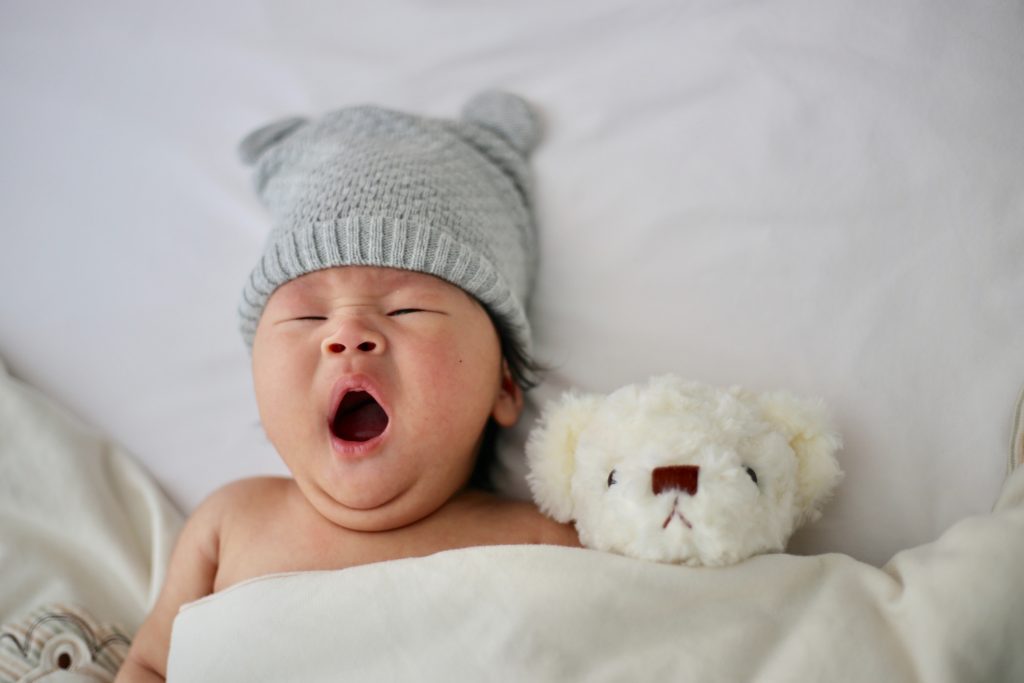One of the easiest things you can do to help get your child sleeping through the night is to create what I like to call a “sleep sanctuary,” What do I mean by that? Basically, you want to create an environment for your child that is very calming & comfortable. When you bring your child into this room, you want them to immediately understand that this is where sleep comes quickly and naturally. The good news is that the advice I’m about to share will work for babies, toddlers, or preschoolers. In fact, these tips even work for adults too!
The 5 steps I’m about to share with you will make your child’s nightly journey into sleep easier and much more relaxing — for both of you! Ready?
Step 1: Keep it simple.
To start with, one of the biggest “mistake’’ parents make is creating what I call a “carnival atmosphere” in their child’s room. I know, I know… It’s tempting to cover the walls with all those adorable owl stencils and hang a cute musical mobile over the crib and fill the shelves and crib with stuffed animals. But trust me when I tell you that — when it comes to children’s rooms — less is more. The reason is simply that all this extra “stuff” can be distracting (or downright overstimulating) for a child. And the last thing you want to deal with at bedtime is an overstimulated child! So my advice here is to declutter your child’s room. Or, at the very least, declutter the crib by getting rid of:
• mobiles
• extra blankets
• stuffed toys
• pillows
• cushions
• positioning devices
When it comes to your baby’s crib, remember that “Less is Better.” Not only does this create a much more calming sleep space, it’s actually much safer, too! (Sadly, about ½ of all crib deaths and 2/3 of bassinet deaths are caused by suffocation resulting from an overcrowded sleep environment.)
Step 2: Keep it dark.
Opposite to popular belief, babies aren’t afraid of the dark. In fact, most babies actually prefer a darker sleep environment than we adults do! Plus, one of the biggest reasons a baby wakes up too early is simply because they are SO sensitive to even the slightest changes in light levels. In other words, when the morning sky starts to lighten, it can be enough to wake your baby! It’s for this reason that I’m a big fan of “blackout blinds.” (These are those thick blinds or curtains that hotels use to keep it pitch black in your room even when it’s the middle of the day.) These ones on Amazon work great and are well-priced: If you travel, here’s one you can bring with you: And — if you’re on a REALLY tight budget — you can always tape garbage bags to the windows. Not pretty, but it works!
Step 3. Keep it quiet…
But Not Too Quiet I like to tell parents that a baby’s room can never be too dark… but it CAN be too quiet! Why? Because the amount of light that enters your child’s room is something you can control pretty easily. The amount of noise? Not so much. Sure, you can tiptoe around the house and watch TV with the volume at a whisper, but there’s always the chance that somebody’s going to ring the doorbell, call your phone, or drop a pan it the kitchen! With that in mind, I recommend two things: Get your child used to a little bit of “background noise” (like conversation, TV, housework, etc.) from a young age so that they’ll be able to sleep through the part of your life that happens after they go to bed. Try out a white noise machine. A lot of parents swear by these, and I’m a big fan myself! A white noise machine does a great job of “masking” other sounds. However, make sure that you don’t place the machine right beside your child’s crib or bed, as some recent studies suggest that doing so might be bad for your child’s hearing.
Step 4: Keep it cool.
One of the biggest mistakes parents make when putting their babies to bed is “overdressing them. I remember when I was a first-time mom, I was always afraid that my little one was getting cold during the night, I quickly learned that to many layers doesn’t help him sleep better, it caused just the opposite. And I hate to bring this up again, but babies who get dressed in too many layers are at a higher risk of both overheating and SIDS. It turns out that most experts recommend keeping your baby’s room somewhere between 68 and 72 degrees Fahrenheit (20 – 22 Celsius.) In order to keep your baby warm, but not too warm, my recommendation is to use a sleep sack.
Step 5: Keep it calm.
Starting about an hour before bedtime, your child’s bedroom should become an oasis of calm. During the rest of the day, it’s fine to have all kinds of loud, rowdy fun in your child’s room. But for the hour before you put your child down for the night, everything that happens in their bedroom should be quiet and soothing.
This accomplishes TWO very important bedtime goals:
It makes sure you are not getting your child excited / overstimulated right before bed. Remember how excited you used to get on Christmas eve as a child? That’s what a rousing game of “peek-a-boo” can do to a baby! It helps you “set the tone” for the night. By not engaging in “active play” in the hour before bedtime, your child will understand that fun time is over for the day, and won’t be tempted to try and start playing games with you after you’ve put them to bed for the night. I’m not saying you should turn into some kind of unfeeling robot in the hour before bedtime, of course. I fully encourage cuddles, singing, laughter, storytelling, and so on. Just remember to keep it calm!
And the second one is to give your child the chance to fall asleep on his own. When they don’t get help and get the chance to develop their own sleeping skills, they know how to go back to sleep when they wake up at night, we all wake up several times at night but mostly we don’t remember. Off course when your little one still needs a night feed he will wake up for it and let you know he is hungry. But when they develop these skills they will drop the night feeds on their own when they don’t need them anymore and go back to sleep calm and peacefully.

